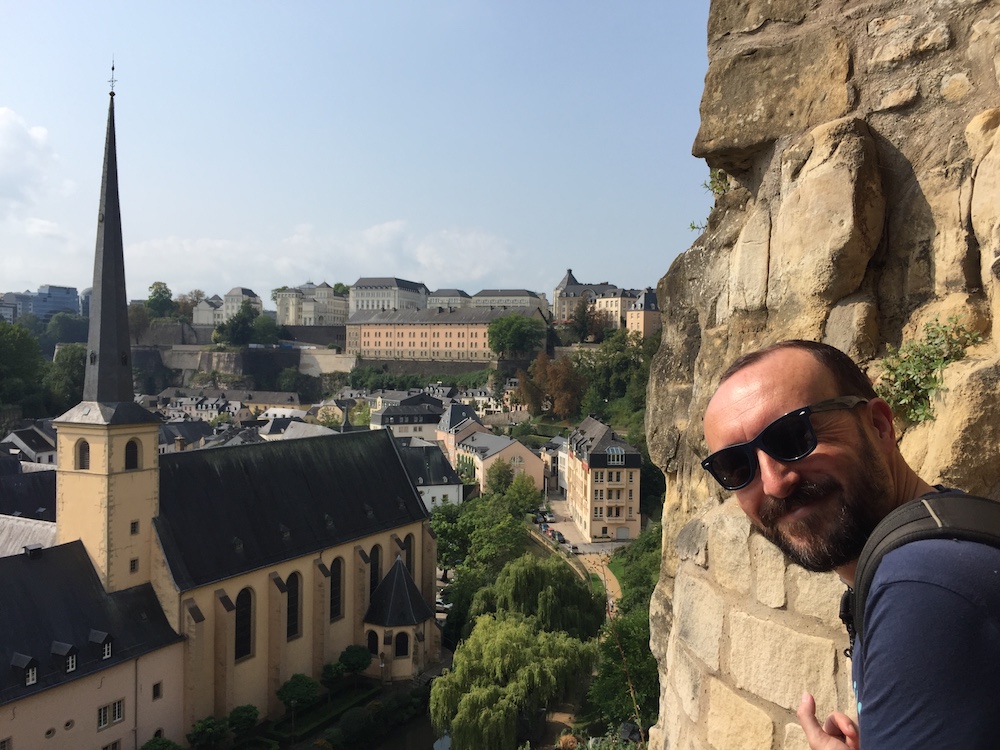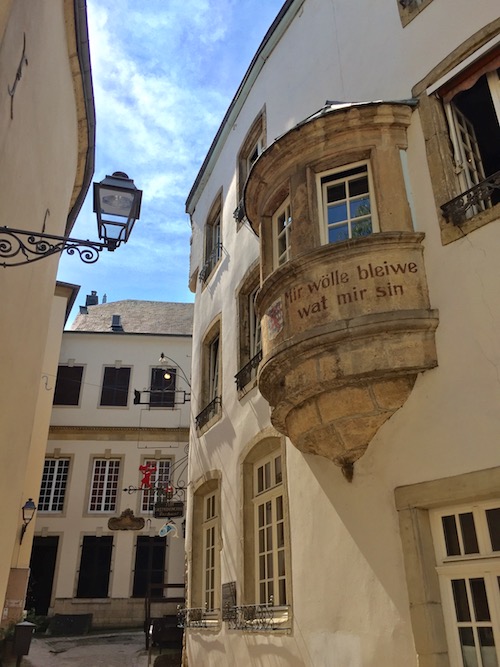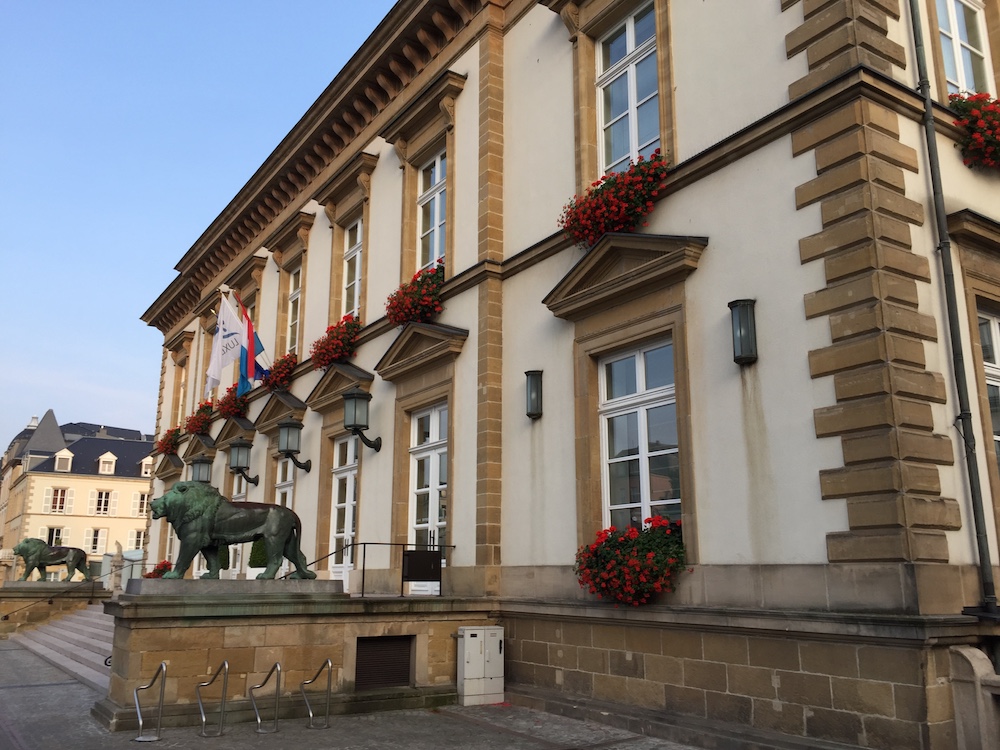Small but perfectly formed, Luxembourg is one of the Low Countries, a founding member of the EU and our choice for a hot and sunny August bank holiday weekend.
Its capital, Luxembourg City, is equally modest but turned out to be a real charmer, easily walkable and attractive. Our first day in town was spent discovering its history on the Wenzel Walk and exploring the cool caves of the Bock Casemates. Not even a headache, the result of drinking lager pre-flight, in-flight and post-flight the night before, could dampen my appreciation of this diminutive city.
We’d flown in from London City Airport on a Luxair Q400, a cramped but perfectly pleasant experience, and caught a pricey cab to our hotel. The Simoncini is right in the heart of the old town, a modern, white, polished residence that shares a building with the owners’ art gallery. Indeed, a fair share of contemporary pictures and sculpture can be found throughout the hotel’s rooms and public spaces.

With an hour or two left of the night, we walked up the road to the Place d’Armes and drank a few beers in a bar called La Lorraine, while an excellent band entertained us and a small crowd on the tree-lined square as part of a summer music festival.
We had a light continental breakfast at the hotel the following morning before we went out to explore the pedestrianised city centre. The Place d’Armes in daylight was busy but a bit touristy and home to a Saturday morning antiques market, while the nearby Place Guillaume II hosted foodie stalls. A band played and the handsome Hotel de Ville dominated the square, but hoardings were up to cover work being done on an underground car park.

The Wenzel Walk – named after a Duke of Luxembourg who built one set of the city’s many defences in the early 15th century – was an ideal way of seeing the old city and discovering its history. We started on the Bock Promontory, a rocky outcrop from which we saw for the first time the city’s dramatic setting. The historic civic heart sits atop towering sandstone cliffs, while the Alzette river runs through the looping valleys below. Beyond stands the plateau of Kirchberg, with its more modern developments and most of the EU offices. The setting reminded me of Matera in Italy.
The Bock, a hugely strategic piece of land, was bought in 963 by Siegfried, Count of Ardenne, who built a castle on it that helped kick-start the development of the city. The cool, eerie Bock Casemates are the massive defensive structures built into the cliffs, part of the UNESCO World Heritage Site, and made up of a maze of tunnels, rooms, cannon emplacements and quarters for the military. Work began in the 17th century and they were used up until 1867, when the city’s fortifications were dismantled as part of an international treaty. In the two World Wars, however, they were brought into use as shelters.

We explored, Graham experiencing the occasional bout of claustrophobia as we wound our way through caverns and tunnels and up and down cramped staircases, clambering between the floors and the layers of history. Occasionally we emerged into the open air to enjoy views of the town and the other immense defensive structures and fortress walls that had earned Luxembourg the nickname ‘Gibraltar of the north’.
The Wenzel Walk took us down the Corniche, a street atop one of those defensive walls and one lined with attractive houses. Going downhill, we passed terraced gardens with the cliffs of the Bock to our left and the slow-moving waters of the Alzette to our right. We were in the middle of a capital city but it felt like we were walking through a quaint, historic village. We crossed the river on an ancient stone bridge, stopped for refreshments in the grounds of the old Neimenster Abbey, which is now an arts and culture centre, and walked on past the rediscovered remains of the old city moat. Back up top, on the Rham Plateau, stood more fortifications and a retirement and medical centre.

The walk took us towards the imposing stone viaduct that carries the main railway line through the city and then back towards the twee district known as Grund, which is divided by the river and absolutely beautiful. Scott’s, a British-style pub, was a perfect lunchtime stop on one side of the bridge and offered us good beer and a barbecued burger. The sun shone and life was perfect.
Sadly what goes down must go back up again and we trudged to the top of the hill, panting and aching. Our destination was the modern and unstuffy City History Museum, housed in converted historic buildings that had been stripped back to brick and stone and included the largest lift I’ve seen anywhere. The museum did an excellent job of telling the city’s story from its earliest days through to the modern era, with the help of intricate wooden town models and fascinating photos from the 19th and early 20th centuries. A highlight was a model of a planned European HQ that was never built but, as a mix of sci-fi and 50s retro cool, would’ve been an amazing addition to the cityscape.

On the way home via the beautiful narrow alleys and streets we stopped for a few beers at the Go-Ten bar, right by the Grand Ducal Palace and countless other historic buildings. Later in the evening we ate at Am Tiirmschen, an old-fashioned restaurant in the historic centre of town that’s best known for its traditional local grub. Graham stuffed his face with smoked pork while I shovelled back a slab of veal with cheese and ham. And very nice it was too, washed down with a slightly sweet Luxembourg Riesling. It will never win awards but it filled us heartily.
We finished the night near the palace again, stopping outside Palais bar for several vodkas and gins. The street was rammed with people and music blared out. Locals mixed with ex-pats and tourists, young with old, girls with boys. And with all that racket going on, I could understand why the Grand Duke and his family choose to live in a castle 20km away…


